 |
Analysis of Data from Designed Experiments |
 |
|
Partially Confounded Factorial Experiment |
Analysis Using SAS
Analysis Using SPSS
To
test the equality of treatment combinations and
identification of best treatment combination requires
analysis to be performed on treatment combinations.
Therefore, 27 treatment combinations are recoded as:
|
V |
N |
P |
Treatment
(renumbered) |
|
V |
N |
P |
Treatment
(renumbered) |
|
1 |
1 |
1 |
1 |
2 |
2 |
3 |
15 |
|
|
1 |
1 |
2 |
2 |
2 |
3 |
1 |
16 |
|
|
1 |
1 |
3 |
3 |
2 |
3 |
2 |
17 |
|
|
1 |
2 |
1 |
4 |
2 |
3 |
3 |
18 |
|
|
1 |
2 |
2 |
5 |
3 |
1 |
1 |
19 |
|
|
1 |
2 |
3 |
6 |
3 |
1 |
2 |
20 |
|
|
1 |
3 |
1 |
7 |
3 |
1 |
3 |
21 |
|
|
1 |
3 |
2 |
8 |
3 |
2 |
1 |
22 |
|
|
1 |
3 |
3 |
9 |
3 |
2 |
2 |
23 |
|
|
2 |
1 |
1 |
10 |
3 |
2 |
3 |
24 |
|
|
2 |
1 |
2 |
11 |
3 |
3 |
1 |
25 |
|
|
2 |
1 |
3 |
12 |
3 |
3 |
2 |
26 |
|
|
2 |
2 |
1 |
13 |
3 |
3 |
3 |
27 |
|
|
2 |
2 |
2 |
14 |
|
|
|
|
Main Procedure is:
Start →All Programs → SPSS for Windows → SPSS 15.0/ SPSS13.0/ SPSS10.0 (based on the version available on your machine) → Enter data in Data Editor → Analyze → GLM → Univariate → yield → [puts yield under Dependent list: ] → REP → [puts REP under Fixed Factor(s): ] → BLK→ [puts BLK under Fixed Factor(s): ] V → [puts V under Fixed Factor(s):] N → [puts N under Fixed Factor(s):] P → [puts P under Fixed Factor(s):] Continue → Model... [Opens Model dialogue box] → Custom → Build Term(s) → Main effects → [puts V, N and P under Model:] → Interaction → [puts V*N V*P N*P and V*N*P under Model:] → Run All.
For performing analysis, input the data in the following format.
{Here the Replication is termed as REP, three factors as V, N and P, treatment as TRT and block as BLK. It may, however, be noted that one can retain the same name or can code in any other fashion}.
Note:
If one is interested in answering first two questions, then
there is no need of recoding the treatment combinations and
adding the variable TRT in the variable.
Following
are the brief description of the steps along with screen
shots.
·
Open Data editor: Start → All
Programs → SPSS for Windows → SPSS
15.0/ SPSS13.0/ SPSS10.0

· Enter data in SPSS Data Editor. There are two views in SPSS Data Editor. In variable view, one can define the name of variables and variable types string or numeric and data view gives the spreadsheet in which data pertaining to variables may be entered in respective columns. In the present case, we enter data in numeric format.
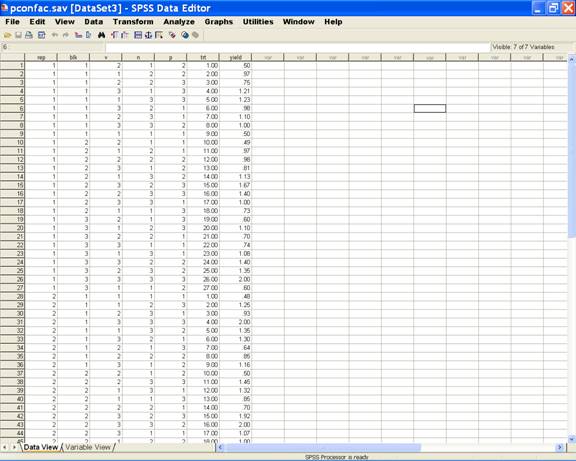
·
Once the data entry is complete, Choose
Analyze from the Menu Bar. Now select Analyze
→ General linear Model → Univariate.

·
This selection displays the following screen.
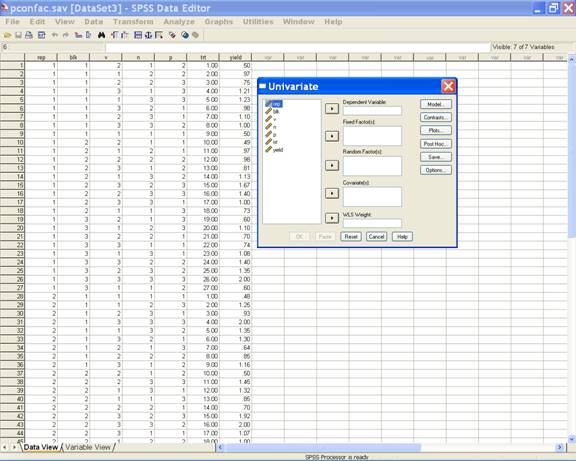
·
Select yield and send
it to the Dependent Variable box; REP, BLK, V, N and P may
be selected for Fixed Factor(s) box. After doing these
the dialog box should be like this

· For the Interactions select Model in the Univariate dialog box i.e. → Model... [Opens Model dialogue box] → Interaction→ V → N → [puts V*N under Model:]. Similarly V*P, N*P and V*N*P can also be put under model.
This selection displays the following screen.

·
Click Continue to return to the
Univariate dialog box.
·
All possible pair wise
treatment comparisons can be performed using the Button Options
on the dialogue box. A click on Button Options, gives
the option for estimated marginal means and display means
for. From the left hand box, take the effect treatment in
the Display means for. Then check the box Compare main
effects and then there are 3 options for confidence interval
adjustment viz. LSD(none), Bonferrnoni and Sidak. Any one of
these 3 options can be selected. Default option is LSD(None).
A screen shot for these options is

This,
however, gives comparisons of single factor level means and
provides only the means for 2 factor level combinations and
3-factor level combinations. For 2-factor and 3-factor level
combinations pairwise comparisons or post hoc comparisons
cannot be performed using SPSS.
·
Click Continue
to return to the Univariate dialog box and Click Paste to go
to the Syntax editor mode and in the model define blk(rep)
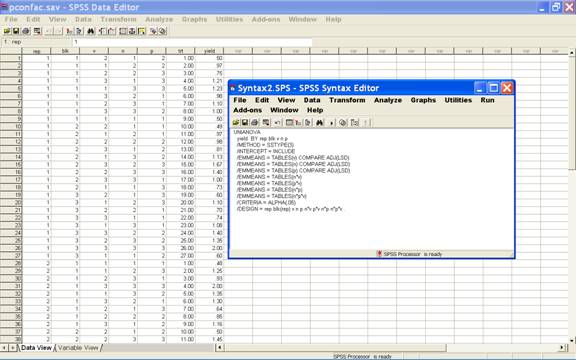
-
Click Run → All
For testing the significance of treatment combination, identification of best treatment combination use the following steps:
·
Choose Analyze from the Menu Bar. Now select Analyze
→ General linear Model → Univariate.
Select yield and send it to the Dependent Variable box; REP, BLK and TRT to the Fixed Factor(s) box.

·
Select Model in the Univariate dialog box i.e.
→ Model... [Opens Model dialogue box].
Put REP, BLK and TRT under the model for main effects.
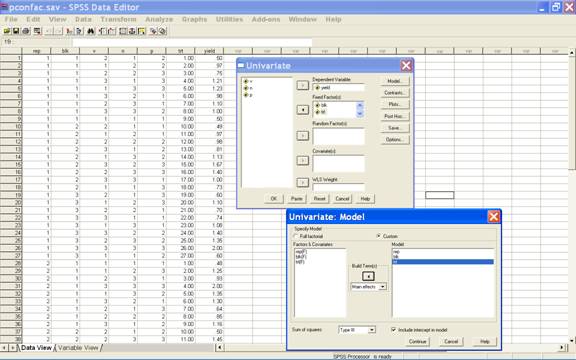
·
Click Continue to return to the
Univariate dialog box.
·
All possible pair wise treatment comparisons
can be performed using the Button Options on the
dialogue box. A click on Button Options, gives the option
for estimated marginal means and display means for. From the
left hand box, take the effect treatment in the Display
means for. Then check the box Compare main effects and
then there are 3 options for confidence interval
adjustment viz. LSD(none), Bonferrnoni and Sidak. Any one of
these 3 options can be selected. Default option is LSD(None).
A screen shot for these options is
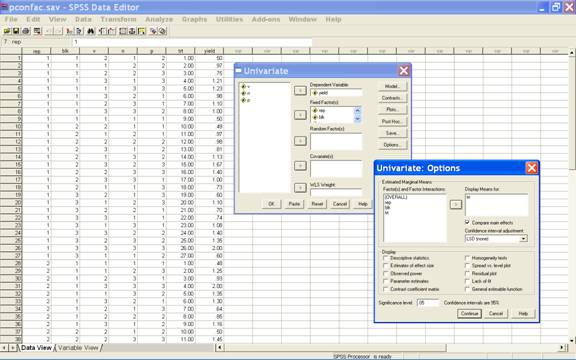
·
Click Continue
to return to the Univariate dialog box and Click Paste to go
to the Syntax editor mode and in the model define blk(rep)

-
Click Run → All
-
To answer all the questions 1 to 3, the following syntax may be used after creating the data file.
UNIANOVA
yield
BY rep blk v n p
/METHOD = SSTYPE(3)
/INTERCEPT = INCLUDE
/EMMEANS = TABLES(v) COMPARE
ADJ(LSD)
/EMMEANS = TABLES(n) COMPARE
ADJ(LSD)
/EMMEANS = TABLES(p) COMPARE
ADJ(LSD)
/EMMEANS = TABLES(n*v)
/EMMEANS = TABLES(p*v)
/EMMEANS = TABLES(n*p)
/EMMEANS = TABLES(n*p*v)
/CRITERIA = ALPHA(.05)
/DESIGN = rep blk(rep) v n p
n*v p*v n*p n*p*v .
UNIANOVA
yield
BY rep blk trt
/METHOD = SSTYPE(3)
/INTERCEPT = INCLUDE
/EMMEANS = TABLES(trt) COMPARE
ADJ(LSD)
/PRINT = DESCRIPTIVE
/CRITERIA = ALPHA(.05)
/DESIGN = rep blk(rep) trt .
Analysis Using SAS Analysis Using SPSS
Home Descriptive Statistics Tests of Significance Correlation and Regression Completely Randomised Design RCB Design
Incomplete Block Design Resolvable Block Design Augmented Design Latin Square Design Factorial RCB Design
Partially Confounded Design Factorial Experiment with Extra Treatments Split Plot Design Strip Plot Design
Response Surface Design Cross Over Design Analysis of Covariance Diagnostics and Remedial Measures
Principal Component Analysis Cluster Analysis Groups of Experiments Non-Linear Models
Copyright Disclaimer How to Quote this page Report Error Comments/suggestions
(Under Development)
For exposure on SAS, SPSS,
MINITAB, SYSTAT and
MS-EXCEL for analysis of
data from designed experiments:
Please see Module I of Electronic Book II:
Advances in Data Analytical Techniques
available at Design Resource Server (www.iasri.res.in/design)